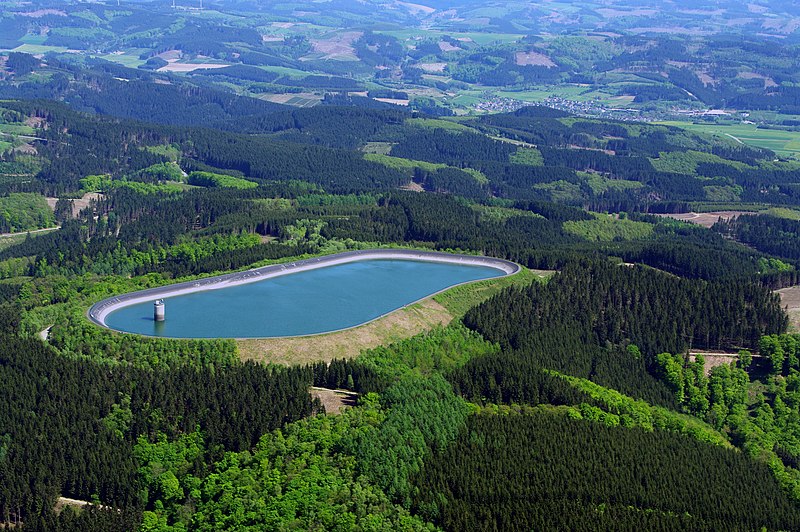 Pumped Storage Hydropower Plant Reservoir, Rönkhausen Germany, by Dr.G.Schmitz
Pumped Storage Hydropower Plant Reservoir, Rönkhausen Germany, by Dr.G.Schmitz
Five Emerging Technologies That Could Change the Way We Store Energy
While clean energy is the key to unlocking a new and green future, it faces one major challenge: storage. Renewable energy is very good at producing energy; however, due to natural inconsistencies in their sources, like weather patterns, renewables experience fluctuations in their availability. As conditions like cloud cover and wind vary, renewables may over- or under-produce electricity, leaving surpluses or gaps in power availability. Critical to making up for the gaps in availability are methods to store surplus electricity created during periods of high generation or low demand so that it may be utilized later when generation is low. Luckily, many companies worldwide are looking for and investing in new and innovative energy storage systems to tackle this problem. Below are five unique and upcoming types of energy storage that might be the key to capturing all the excess clean energy produced.
1. Heated Rock Beds
This energy storage system stores thermal energy in rock beds and is coming out of a solar company called CSolPower out of Albuquerque, New Mexico. This company aims to use rock beds that are heated by solar panels during off-peak electricity times, to release that stored energy when there is a spike in energy needs. CSolPower prioritizes long-term term energy storage and implied that the heated bed could store energy for months. Thus, if the system is scaled up, the rock bed could maintain a prolonged high-energy state, ready to release that energy when needed. Furthermore, this type of energy storage is cost-efficient. CSolPower stated that it could use landscaping gravel with minimal preparation and then be ready to use in an energy storage system. These systems can also be built anywhere and do not require extensive permitting.
2. Liquid Air/Cryogenic Energy Storage
Liquid air or Cryogenic energy storage may seem like an oxymoron. Still, liquid air is a clean and efficient way to store energy and could solve many problems with different energy storage types. In this type of storage, air is sucked in from outside and is cooled to below -196 degrees Celsius. Then, when energy is needed, the air is warmed and pressurized and used to operate a turbine and produce electricity. Compared to other energy storage systems, cryogenic energy storage can be built with already-established technology and without many rare metals. This type of storage is still in its infancy, but it could bolster local energy security and provide energy when other forms are unavailable in the right circumstances.
3. Gravity battery
Gravity batteries are an interesting and clean way of energy storage that relies on a resource that is both unlimited and simple. It depends on turning potential energy from weights it raises to high heights during excess electricity. Then, at times of increased need for electricity, it drops those lifted weights and turns the potential energy into kinetic energy that generates electricity. This system is modular, says Gravitricity, an Edinburgh-based green engineering start-up. Instead of replacing the entire system when one part isn’t working, they can replace the individual part and not need to start over. Furthermore, these gravity batteries can be implemented in abandoned mines worldwide. So, instead of letting these mines go to waste, they can be turned into energy storage systems. Pumped storage hydropower is also another form of a gravity battery.
4. Hydrogen Storage
Hydrogen is a good clean energy source because the only byproduct it produces is water. However, various ways to produce hydrogen defeat its intent as a source of clean energy. The International Renewable Energy Agency says that hydrogen is most efficient when used in conjunction with the shipping industry, steelmaking, and chemical and refining industries. use natural gas, brown coal, and coal, respectively, to isolate hydrogen. Blue hydrogen also uses natural gas to separate hydrogen but uses carbon capture technology to store the excess carbon underground. Lastly, green hydrogen is produced by a chemical reaction called electrolysis, which produces no carbon dioxide as a byproduct. Once the hydrogen is produced, it can be cooled, pressurized, and stored. Then, when there is a spike in electricity needs, hydrogen can be used instead of natural gas to heat and provide energy to homes, power cars and buses, or power generators.
5. Flow batteries
A flow battery is an electrochemical battery that can store hundreds of megawatt-hours of energy—enough to keep thousands of homes running for many hours on a single charge. This battery works by having two tanks of liquid electrolytes, it “employs reduction (a gain of electrons) and oxidation (a loss of electrons) reactions as electrons are transferred in the electrolyte. Energy is stored in the electrolyte, which flows through the battery during charge and discharge.” Furthermore, because of their design, these batteries have low costs and a higher longevity than regular batteries. These batteries, however, produce a large amount of waste that doesn’t break down over time, so this problem needs to be addressed before large-scale production of these batteries should be completed. Flow batteries are an emerging technology that, while not perfect, could provide more reliable long-term storage for smaller grids nationwide.





